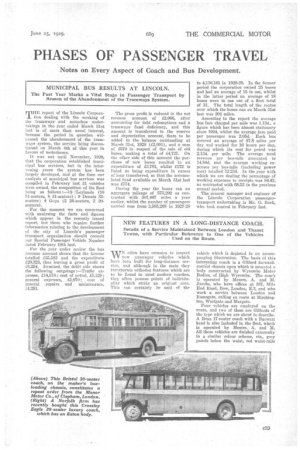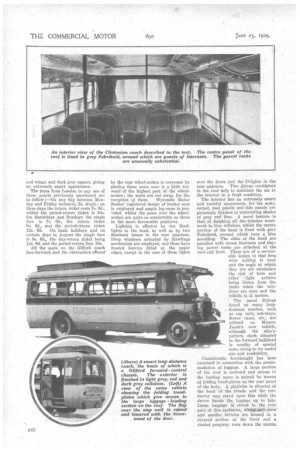PHASES OF PASSENGER TRAVEL
Page 61

Page 62

Page 63

If you've noticed an error in this article please click here to report it so we can fix it.
Notes on Every Aspect of Coach and Bus Development.
MHE report of the Lincoln Corporal._ don dealing with the working of the trarawaye and motorbus undertakings in the year ended March 31st last is of more than usual interest, because the period in question witnessed the abandonment of the tramways system, the service being discontinued on March 4th of this year in favour of motorbuses.
It was not until November, 1920, that the corporation established Municipal bus services, but in the intervening years the system has been largely developed, and at the time our analysis of municipal bus services was compiled in February last 31 vehicles were owned, the composition of the fleet being as follows :-18 1Leylands (10 51-seaters, 8 31-seaters) ; 9 Dennis =seaters ; 4 Guys (2 26-seaters, 2 20seaters).
For the moment we are concerned with analysing the facts and (figures which appear in the recently issued report, but these who require further information relating to the development of the city of Lincoln's passenger transport organization should consult our Special Passenger Vehicle Number dated February 19th last.
For the year under review the bus revenue account shows that the income totalled £35,582 and the expenditure £29,328, thus leaving a gross profit of 16,254. Itemized, the debit side shows the following outgoings :—Traffic expenses. £14,818; cost of petrol, £5,129; general ex-penses, £5,070; cost of general repairs and maintenance, £4,251. The gross profit is reduced in the net revenue account of £2,066, after accounting for debt redemptions and a tramways fund deficiency, and this amount is transferred to the reserve and depreciation account, there to be added to the balance outstanding at March 31st, 1928 (12,091), and a sum of £570 in respect of the sale of old buses, making a total of £4,727. On the other side of this account the purchase of new buses resulted in an expenditure of £3,781, whilst £172 is listed as being expenditure in excess of loan transferred, so that the accumulated fund available on March 31st last was £774.
During the year the buses rah an aggregate mileage of 575,202 as contrasted with 507,407 miles a year earlier, whilst the number of passengers carried rose from 3,585,268 in 1927-28 to 4,136,161 in 1928-29. In the former period the corporation owned 25 buses and had an average of 15 in use, whilst in the latter period an average of 18 buses were in use out of a fleet total of 31. The total length of the routes. over which the buses ran on March 31st last was 2071 According to the report the average bus fare charged per mile was 1.13d., a figure which has been almost stationary since 1924, whilst the average fare paid per passenger was 2.05d. Each bus covered an average of 87.8 miles per day and worked for 16 hours per day, during which its cost for petrol was 2.13d. per mile. The average total revenue per bus-mile amounted to 14.84d. and the average working expenses per. bus-mile (including power cost) totalled 12.23d. In the year with which we are dealing the percentage of working expenses to receipts was 84.42, as contrasted with 68.53 in the previous annual period.
The general manager and engineer Of the Lincoln Corporation passengertransport undertaking is Mr. 0. Rock, who took control in February last.
WE often have occasion to inspect pew passenger vehicles which have been built for long-distance service, and although in the main they incorporate orthodox features which are to be found in most modern coaches, they often possess points of individuality which strike an original note. This can certainly be said of the
vehicle which is depicted in an accompanying illustration. The basis of this interesting coach is a Gilford forwardcontrol chassis upon which is mounted it body constructed by Wycombe Motor Bodies, of High Wycombe. The coach is operated by Messrs. A. and M. Jacobs, who have offices at 387, Mile End Road, Bow, London, E.3, and who work a service between London and Ramsgate, calling en route at Birching
ton, Westgate and Margate.
Four vehicles are employed on the route, and two of them are Gilfords of the type which we are about to describe. A Beau 17-seater coach with a Barwatt head is also included in the fleet, which is operated by Messrs. A. and M. All these vehicles are finished externally in a similar colour scheme via, grey panels below the waist, red waist-rails and wings, and dark grey uppers, giving an extremely smart appearance. ,
The fares from London to any one of those -points previously mentioned are as follow :—On any day between Monday and Friday inclusive, 5s. single; on these days the return ticket costs 7s. 6d., whilst the period-return ticket is 10s. On Saturdays and Sundays the single fare is 7s. 6d., the return ticket 9s. 6d., and the _ period-return ticket 12s. 6d. On bank holidays and on certain days in August the single fare is Ss. 6d., the day-return ticket being 13s. 6d. and the period-return fare 15s.
All the seats on the Gifford coach face forward, and the obstruction offered by the rear wheel-arches is overcome by placing those seats near it a little forward of the highest part of the wheelarches ; the seats are cut away for the -reception of them. Wycombe Motor Bodies' registered design of bucket seat is employed and ample leg-room is provided, whilst the seats over the wheelarches are quite as comfortable as those in the more favourable positions.
Lighting is effected by ten floodlights in the head, as well as by two flainbeau lamps in the rear quarters. Drop windows actuated by Rawlings mechanism are employed, and these have frosted louvres fitted at the upper edges, except in the case of those lights over the doors and the D-lights in the rear quarters. Two Airvae ventilators in the roof help to maintain the air in the interior in a fresh condition.
The interior has an extremely statist and tasteful appearance, for the seats, carpet, roof panels and side panels are pleasingly finished in contrasting shades of grey and blue. A novel feature is that of ...finishing. all the interior woodwork in blue cellulose, whilst the centre portion of the head is lined with grey Fahrikoid, around which runs a blue moulding. The sides of the head are panelled with cream linerusta and sloping parcel racks Are attached at the cant-rail level. These are of a serviceable design in that firm wire netting is used and the angle at which they are set minimizes the risk of hats and other light articles being blown from the racks when the windows are open and the vehicle is in motion.
The usual fittings found on many longdistance coaches, such as rug rails, ash-trays, flower vases, etc., are utilized on Messrs. Jacob's new vehicle, although the ship'spattern clock situated in the forward bulkhead is worthy of special note, owing to its useful size and readability.
Considerable forethought has been exercised in connection with the accommodation of luggage. A large portion of the roof is enclosed and access to the loading space is gained by means of folding trend-plates on the rear panel of the body.A platfoim issituated,at the head of the treads and the conductor may stand upon this while ' the driver hands the luggage up to him. Large baggage is stored in the rear part of this enclosure, whilat4mit-eitses Mid smaller articles are housed in a covered section at the front and a slatted gangway runs down the centre.
MHE Mexborough and Swinton Trac tion' Act, which has now been passed into law, was put forward for the purpose of enabling the promoting company to ran buses on the trolleyvehicle routes and on certain other routes and to make other provision for the trolley-bus undertaking. One of the main purposes of the Bill was to enable the company to obtain protecthm for the working of its trolley-bus routes and certain motorbus routes from the competition of the owners of other motorbuses.
Negotiations were entered into between the Rotherham Corporation and the company with a view to securing that this protection should extend. to the trolley-bus route in the borough of Itutherham, which was proposed to be operated jointly under a working agreement by the corporation. and the co inpa.n y.
Parliament, in the company's Act, has now afforded this protection, and it is to extend to any other route which would operate in 'competition with the specified route.
The Act further deals with'the question of the company being empowered to provide, work and maintain new bus routes in various parts of the area. The object. of the company and the corporation was to enable either, or both, to augment the trolley-bus service by a motorbus service when that should be found .necessary. The company, in its Act, also took power to establish new routes, with the consent of the Minister of Transport and of the local and road authorities, and, in the event of the latter being unreasonably withheld, authority was given for the Ministry of Transport to determine the question as to. whether such consent should be. given or not. In the ease of the corporation, however, a protective clause has been inserted in the Act restricting this power of the Minister of Transport in so far as it
affects the-Rotherham Corporation. •
A further provision has been inserted in the Act, giving the corporation power to enter into working agreements with the company in respect to any motorbus service which the company is authorized to provide. For this purpose the powers contained in Section 72 of the Rotherham Corporation Act, 192S, which dealt exclusively with .trolley-buses, has been extended to motorbuses, subject, however, to a pro
viso that in the case of motorbuses operating along a new route, the consent of the local and road authority is to be obtained, but in the event of such consent .being unreasonably withheld, • the Minister of ,Transport may -make an Order-dispenaing withit •
Valuable clauses have been obtained by the cereration, both for the pre • teetion of part of its trolley-vehiele and motorbus services in the borough, and for enabling it to extend its services of motorbuses in districts outside the
borough. It now remains for the corporation to enter a working agreement with the company in respect of its new and-, proposed motorbusroutes, and extending the working arrangements in respect of its trolley-vehicle routes.
A Double-decker with a Detachable Top.
A BRIEF mention was made in a 11. recent issue of this journal to the fact that one of the most interesting
exhibits at the recent Fair in Milan was a double-deck bus body constructed by the Societa Carrozzeria Varesina, of Varese, and mounted on a Lancia six-cylinder Omicron chassis. We are now able to publish an illustration of • the vehicle, one of the interesting • features of which is that the covered top is removable down to the level of the bottom of the windows, thus making the bus suitable for use in both the summer and the winter.
The body, which has accommodation for 70 sitting passengers and standing room for a number of additional " fares," is also interesting in that it is constructed of a light metal known as Lautal, the weight of the body complete being stated to be under 2i tons. The staircase leading to the upper deck is entirely enclosed and both the entrance door at the back and the exit door at the front open outwards and are controlled by the driver.
We learn that the lens has now been in regular service for several weeks, and that so far it has given every satisfaction.












































































































